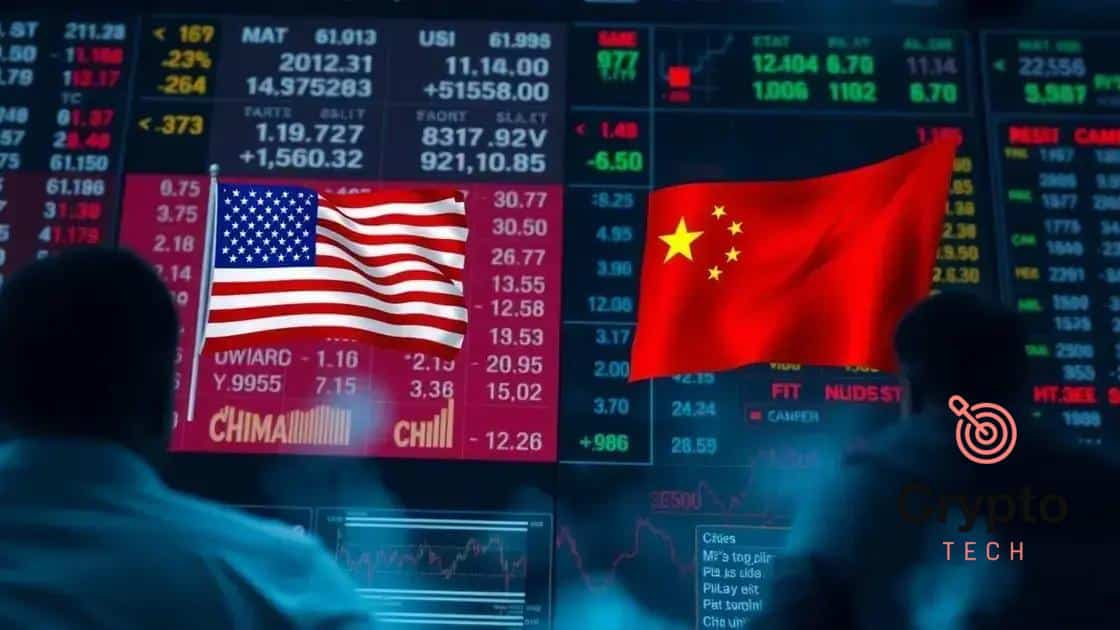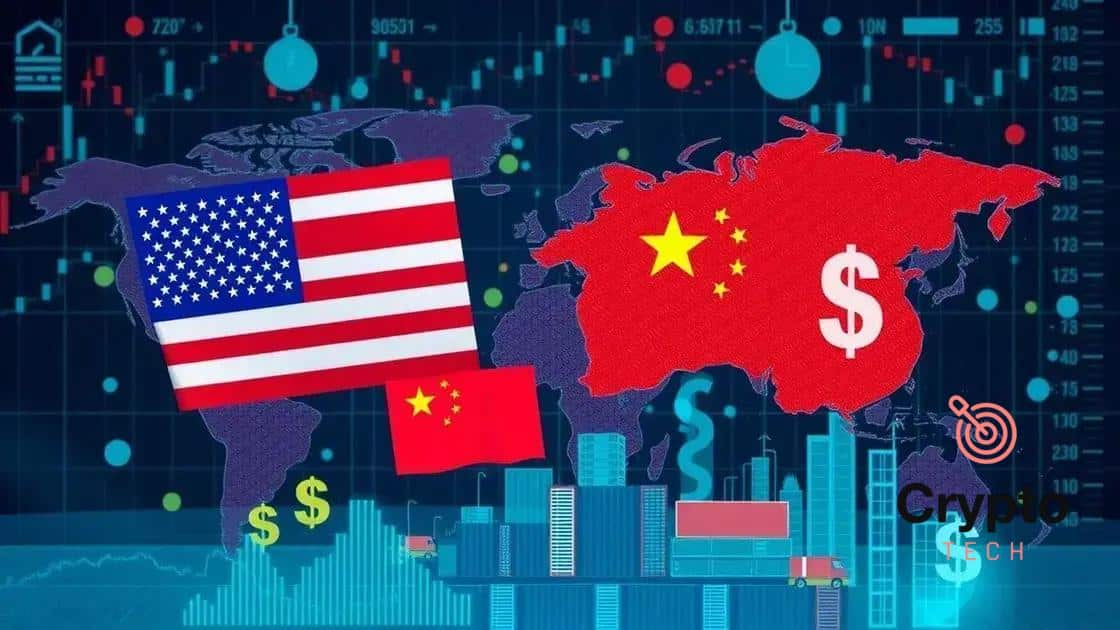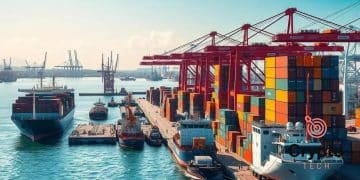Financial repercussions of the US-China trade conflict

The US-China trade conflict significantly impacts global economic relations, with tariffs affecting multiple industries, navigating the need for risk mitigation strategies, and creating an uncertain future outlook that requires constant observation and adaptation.
Financial repercussions of the US-China trade conflict are profound and far-reaching. As these two economic giants navigate tension, understanding the impact on businesses and investors is essential. How will these changes affect your financial decisions?
Overview of the US-China trade conflict
The US-China trade conflict has become a pivotal issue in global economics. Understanding its core elements can help us grasp its extensive impact on economies worldwide. Trade between these nations has formed the backbone of numerous industries, but it is now at a crossroads.
Historical Context
To understand the current situation, we should look back. The tariffs and trade barriers have roots that go back years, driven by various factors such as intellectual property theft and trade imbalances. As these two major economies interact, their policies can create ripples across the globe.
Key Drivers of the Conflict
Several issues fuel this conflict, including:
- Tariffs: High tariffs have been imposed on a range of products.
- Trade imbalances: The trade deficit has raised significant concerns.
- Intellectual property theft: Allegations have been made against China regarding the mishandling of IP rights.
These elements create a complex web of challenges that affect both countries and the global market. The financial repercussions extend beyond mere trade figures; they impact jobs, consumer prices, and investment stability.
Current Situation
As negotiations continue, the uncertainty remains a significant hurdle for businesses and consumers alike. Companies must adapt to these changes and prepare for any regulatory shifts. Below are some ways businesses can respond:
- Monitor policy changes closely.
- Diversify supply chains to minimize risk.
- Engage in lobbying efforts for favorable policies.
Understanding the US-China trade conflict is crucial for making informed business decisions. With so many moving parts, staying informed can empower stakeholders to navigate these turbulent waters effectively.
Economic impacts on global markets

The economic impacts of the US-China trade conflict extend far beyond both countries’ borders. As these two economic powerhouses clash, the ripples affect global markets, influencing everything from consumer prices to investment flows.
Trade Volatility
As tariffs fluctuate, businesses are forced to react quickly. The uncertainty can cause volatile markets, where stock prices can sway dramatically based on news of new tariffs or negotiations. This creates challenges for investors trying to make informed decisions.
Supply Chain Disruptions
Many companies rely on parts sourced from either the US or China, making them vulnerable to disruption:
- Increased costs: Tariffs lead to higher production costs.
- Delayed shipments: Customs delays can slow down the supply chain.
- Diversification needs: Companies often look to diversify suppliers to mitigate risks.
These factors cause businesses to rethink their strategies. Companies might seek alternative suppliers or shift production to avoid high tariffs. This dynamic environment makes it harder to predict future costs and pricing.
Consumer Impact
It’s not just businesses feeling the heat; consumers also experience the fallout. Prices for goods may rise as companies pass on costs from tariffs. Basic products, like electronics and clothing, could become more expensive. Consumers may need to adjust their budgets and purchasing habits, impacting overall economic spending.
Global economies are also influenced by these conflicts. Emerging markets, especially those with close ties to either the US or China, can find themselves caught in the middle. They might face reduced exports or investment as the major players focus inwards.
Key industries affected by tariffs
The tariffs resulting from the US-China trade conflict have significantly impacted various industries. Understanding which sectors are most affected can help businesses and consumers navigate these changes effectively.
Technology Sector
The technology industry stands out as one of the most affected. Companies rely heavily on components from both countries, making them vulnerable to tariff fluctuations. Major tech products like smartphones and laptops can see price increases, impacting both manufacturers and consumers.
Agriculture and Food Products
Agricultural products have also felt the strain of rising tariffs:
- Soybeans: American farmers face challenges as China imposes tariffs on U.S. soybeans.
- Meat products: Tariffs on U.S. meat exports can lead to reduced market access in China.
- Fruit and vegetables: Higher costs may impact prices for consumers.
As a result, U.S. farmers may seek new markets or adjust production methods to adapt, creating shifts in the global food supply chain.
Automotive Industry
The automotive sector is another critical area affected by tariffs. Many car parts are sourced internationally. Tariffs can inflate the costs of vehicles, leading to:
- Higher prices: Consumers may pay more for new cars.
- Job impacts: Workforce adjustments and changes in production levels may occur.
- Investment shifts: Companies might reconsider where to build or source production.
The automotive industry must navigate these challenges while also adapting to changing consumer demands for more environmentally friendly options.
In conclusion, the ripple effect of tariffs reaches numerous sectors. These industries face ongoing challenges, and remaining aware of these impacts is crucial for consumers and businesses alike.
Strategies for mitigating financial risks
In the face of the US-China trade conflict, companies must adopt strategies to mitigate financial risks. Effective risk management can help businesses navigate uncertainties and protect their bottom line.
Diversification of Supply Chains
One key strategy is diversifying supply chains. This can reduce dependency on any single supplier or region. Companies can:
- Identify alternative suppliers in different countries.
- Invest in local production to minimize exposure to tariffs.
- Enhance logistics to adapt quickly to changing conditions.
Diversification not only shields against tariff impacts but also creates more resilience in supply operations.
Financial Hedging
Another effective method is financial hedging. Businesses can use various financial instruments to protect against price fluctuations:
- Futures contracts can lock in prices for commodities.
- Options contracts allow companies to secure prices without mandatory purchase.
- Currency swaps can mitigate risks related to exchange rate changes.
By hedging, companies can stabilize their financial performances despite market volatility.
Regular Risk Assessments
Conducting regular risk assessments is critical. Businesses should continuously analyze their exposure to different risks. This process can lead to:
- Identifying new risks that may arise from changing trade policies.
- Adjusting strategies according to market conditions.
- Informed decision-making based on current data.
By staying informed, companies can react promptly to mitigate potential losses.
Future outlook of US-China trade relations
The future outlook of US-China trade relations remains uncertain, shaped by ongoing economic and political developments. As both countries navigate their trade policies, various factors could influence their relationship.
Potential for Negotiation and Cooperation
Despite current tensions, there is potential for negotiation and collaboration. Historically, both nations have engaged in dialogues aimed at resolving issues. Successful discussions could lead to:
- Reduction in tariffs that benefits both countries.
- Stronger trade agreements that promote fair practices.
- Increased market access for various goods.
Such outcomes would likely stabilize the markets and promote economic growth in both nations.
Impact of Global Economic Factors
Global economic trends will also shape the future of trade relations. For instance, changes in consumer demand and shifts in supply chains may lead to:
- Changes in trade volumes as companies seek better options.
- Emerging market influences drawing investment away from both countries.
- Technological advancements that can facilitate trade efficiencies.
Monitoring these factors will be crucial for anticipating how trade relations will evolve.
Political Dynamics
The political landscape in both the U.S. and China will play a critical role as well. Domestic policies and international relations can cause fluctuations in trade. Some considerations include:
- Changing administrations that may adopt different trade strategies.
- Bipartisan support for policies impacting trade negotiations.
- Regulatory changes that affect business operations.
Ultimately, these elements create an intricate web of variables that will determine the future of US-China trade relations.
FAQ – Frequently Asked Questions about the US-China Trade Conflict
What factors are influencing the US-China trade conflict?
The conflict is influenced by tariffs, trade imbalances, and issues related to intellectual property.
How do tariffs affect consumers?
Tariffs can lead to higher prices for goods, impacting consumer purchasing power.
What strategies can businesses use to mitigate financial risks?
Businesses can diversify supply chains, hedge financially, and conduct regular risk assessments.
What is the future outlook of US-China trade relations?
The future is uncertain, but potential negotiations and global economic factors will play significant roles.





